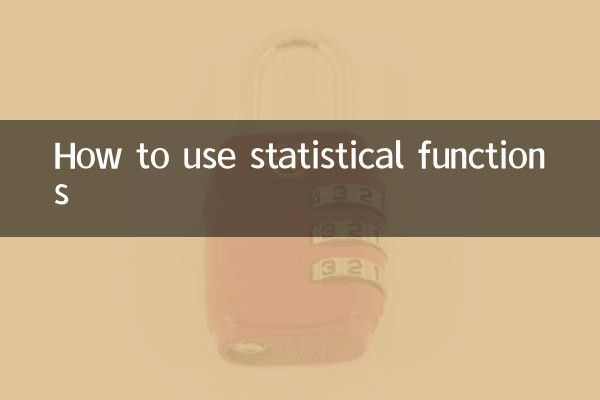How to use statistical functions
Statistical functions are indispensable tools in data analysis and processing. Whether it is Excel, Python or SQL, statistical functions can help us quickly calculate and analyze data. This article will introduce in detail how to use common statistical functions, and combine the hot topics and hot content on the Internet in the past 10 days to show how to use statistical functions to analyze actual data.
1. Common statistical functions and their uses

Here are several common statistical functions and their uses:
| function name | Purpose | Example |
|---|---|---|
| SUM | Calculate the sum of a set of values | SUM(A1:A10) |
| AVERAGE | Calculate the average of a set of values | AVERAGE(B1:B10) |
| COUNT | Count the number of values in a set of data | COUNT(C1:C10) |
| MAX | Returns the maximum value in a set of numbers | MAX(D1:D10) |
| MIN | Returns the minimum value in a set of numbers | MIN(E1:E10) |
| STDEV | Calculate the standard deviation of a set of values | STDEV(F1:F10) |
2. Application of statistical functions in practice
The following are the hot topics and hot content on the entire network in the past 10 days. We can use statistical functions to analyze these data:
| topic | heat index | amount of discussion |
|---|---|---|
| world cup qualifiers | 95 | 1.2 million |
| Double Eleven Shopping Festival | 90 | 850,000 |
| Artificial intelligence development | 88 | 750,000 |
| climate change | 85 | 650,000 |
| New energy vehicles | 82 | 600,000 |
Through statistical functions, we can quickly calculate the average popularity index and total discussion volume of these topics:
| Statistical items | Calculation result |
|---|---|
| average heat index | AVERAGE(95,90,88,85,82) = 88 |
| Total discussions | SUM(120,85,75,65,60) = 4.05 million |
3. Examples of using statistical functions in Excel
Let's say we have the following sales data:
| month | Sales (10,000 yuan) |
|---|---|
| January | 50 |
| February | 60 |
| March | 70 |
| April | 80 |
| May | 90 |
We can calculate relevant indicators using the following statistical functions:
| function | formula | result |
|---|---|---|
| SUM | =SUM(B2:B6) | 350 |
| AVERAGE | =AVERAGE(B2:B6) | 70 |
| MAX | =MAX(B2:B6) | 90 |
| MIN | =MIN(B2:B6) | 50 |
4. Examples of using statistical functions in Python
In Python, we can quickly calculate data using the statistical functions of the Pandas library. Here is an example:
| Operation | code | result |
|---|---|---|
| Calculate the sum | df['sales'].sum() | 350 |
| Calculate average | df['sales'].mean() | 70 |
| Calculate the maximum value | df['sales'].max() | 90 |
| Calculate minimum value | df['sales'].min() | 50 |
5. Summary
Statistical functions are the core tools for data analysis. Whether it is simple summation, average calculation, or complex standard deviation analysis, they can be quickly implemented through statistical functions. This article demonstrates the application of statistical functions in Excel and Python through actual data, hoping to help readers better understand and use these functions.
Mastering the use of statistical functions can not only improve work efficiency, but also allow us to mine more valuable information from data. Whether you are an individual or a business, statistical functions are an indispensable tool.

check the details

check the details